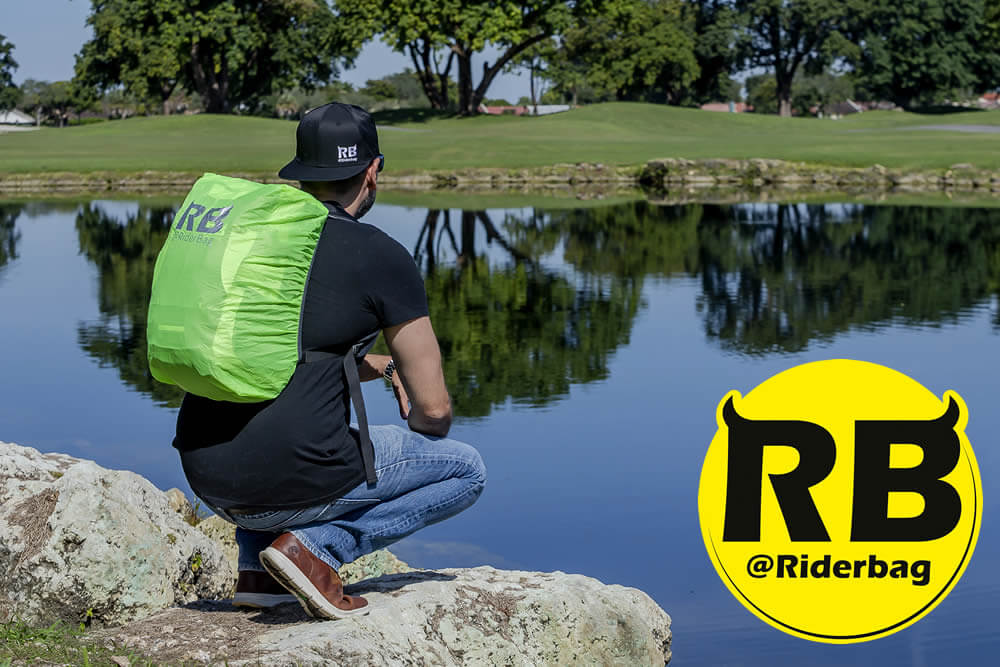Everything you need to know about waterproof backpack covers

Everything You Need To Know About Waterproof Backpack Covers
It’s tough to put a price on peace of mind when you’re staring down a rainstorm with a backpack full of expensive gear. A good waterproof backpack cover is indispensable in that regard, yet some folks are still on the fence for some reason when it comes to weather protection.
To that end, we’ve decided to put together a few of the most important talking points around the subject to help explain why we include a waterproof cover with every Riderbag we make. Below we’ll explain how pack covers work, why they’re important, and what you should look for when shopping for one of your own.
Do Waterproof Backpack Covers Work?
This is a question we hear a lot from our customers, and the answer is a resounding “yes.”
Typically, this question gets brought up because of the nature of our waterproof backpack cover, which stretches up and over the top, bottom, and sides of the bag, but doesn’t actually seal around the area of the pack that’s up against your back. Rest assured, this is an utterly proven design for keeping important gear dry, and you’ll find all the evidence you could ask for in the backpacking community.

The most highly rated hiking pack covers on the market from brands like Osprey, Gregory, and The North Face all share this same approach to waterproofing. Backpackers the world over have put thousands of miles in the pouring rain on pack covers like ours, and the results are well-documented and readily available.
The other common question we get about our pack cover is whether or not it will stay in place while we’re riding a motorcycle at speed. Again, the answer here is yes, as we’ve put hundreds if not thousands of rainy highway miles on our pack covers and have yet to experience a single failure.
What Type of Material is Used for Waterproof Backpack Covers?
Pretty much all waterproof backpack covers come in one of two materials: Nylon or polyester. Both materials have their pros and cons, so let's have a quick overview of each.
Nylon is a popular choice due to its excellent abrasion resistance and naturally stretchy properties. Both of these features bode well for motorcycle use, but nylon also has a major shortcoming: It’s naturally susceptible to absorbing moisture, which makes it much more difficult to effectively waterproof.
Polyester, on the other hand, is a much less pliable fabric and has almost zero stretch compared to nylon. Polyester also has the added benefit of being naturally hydrophobic (it repels water), which makes it a much easier fabric to waterproof using less expensive manufacturing processes. We’ll also note that polyester is naturally more UV resistant than nylon, which means it won’t break down and degrade as quickly as nylon due to prolonged sun exposure.

Regardless of which material is used in your backpack cover, there’s another crucial element that goes into the waterproofing process: Seam taping.
Seam taping is the practice of weaving waterproof synthetic tape into the exposed seams of a waterproof garment. By doing this, you effectively “seal” all the small holes created when sewing two pieces of fabric together, effectively closing off any potential weak points in a backpack cover’s construction.
It’s also important to note that although polyester has a distinct advantage over nylon from a waterproofing standpoint, neither material is fully waterproof on its own, even when fully seam-taped. This is why even the most tightly woven synthetic fabrics require additional chemical treatment to properly seal your backpack off from the weather.
By treating the surface of the fabric with a chemical sealant, you effectively “seal off” all of the tiny spaces between the threads, which transforms a synthetic garment from “water-resistant” to completely waterproof.
What’s the Best Rain Cover Material?
While both nylon and polyester have their pros and cons, polyester is generally considered the better material of the two when it comes to rain protection. Its limited stretch, natural water-repellency, and enhanced UV protection combine to make it a more reliable fabric in all weather conditions, which is why our Riderbag waterproof backpack covers are made entirely from seam-taped polyester.

You could certainly argue that the added toughness of nylon is better suited to the rigors of day-to-day use, but in practice, we’ve found the benefits simply don’t add up. The reduced rain protection of nylon combined with its increased vulnerability to UV damage just aren’t a great fit for our application, and by using a tightly woven polyester fabric in its place, we’re able to achieve similar abrasion resistance without compromising on the important stuff.
Do I Actually Need A Waterproof Cover For My Backpack?
Rain and/or snow protection varies from pack to pack. Most traditional fabric packs are entirely vulnerable to water ingress, while your typical hiking pack is somewhat water-resistant, but not fully waterproof. To that end, you’ll likely want to check with your bag’s manufacturer regarding its protection, but if you’re wearing a Riderbag, you’ve got some of the best water resistance around right out of the box.
That’s because even before you put the included high-viz waterproof cover on, our bag is built to be highly water resistant using a combination of tightly woven 600D nylon and an additional retro-reflective surface treatment. In our experience, our bags keep your gear dry through drizzles and light rain without the need for a waterproof cover, but in an outright downpour, you’ll be glad you’ve got one handy.
We’ll also note that because the pack cover is exceptionally lightweight and compact, we generally recommend carrying it around with you wherever you ride just in case. Better to have it and not need it, as they say.
A Word On Pack Cover Visibility…
When we set out to design the original Riderbag, safety was our top priority. That’s why our bags are made as highly visible as possible, and it’s also why they’re built to accommodate life-saving back protectors as well.

When it comes to waterproof covers for your commuter pack of choice, we’d like to remind you to keep safety and/or visibility high on your priority list. As you already know, rainy weather dramatically reduces visibility, and if you’re throwing a generic pack cover over your high-vis or reflective backpack, you’re putting yourself in serious danger.
That’s why we designed the Riderbag’s waterproof cover in the same high-viz colors and reflective materials as the rest of the pack: You need more visibility in poor weather, not less, and throwing a trash bag, poncho, or rain jacket over your pack just isn’t a risk work taking.
Don’t hesitate, order one of our six hi vis reflective backpacks. They all include a Waterproof Backpack Cover!





Leave a comment